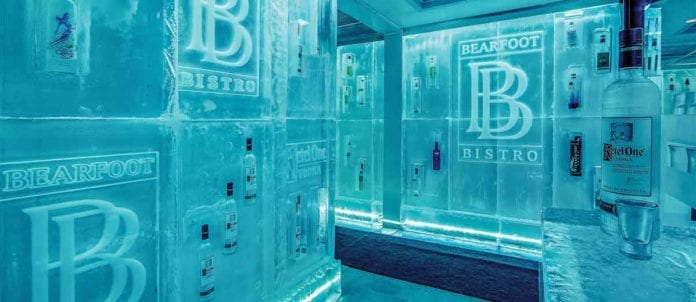Refrigerators and freezers are counted among the more pedestrian of appliances. However, there are also a growing number of operators who believe custom systems are the way to go — whether they’re dealing with space constraints, aesthetics, environmental concerns or specialty menus requiring a fresh perspective on day-to-day prepping processes. For Jason Fisher, owner/brewer at the Indie Ale House in Toronto, having the right refrigeration is key to running a successful brew pub. The 120-seat restaurant does all its brewing on site and also runs a retail beer-to-go section — all of which fuels unique and large refrigeration demands, he says. “The brewery lives on refrigeration that can be dialled into specific temperatures for each of the 10 fermenters so custom was the way to go.”
Fisher says the mechanics of it all can be easily managed with the right supplier. “It’s worth paying a bit extra to make sure you have a good custom builder.” His choice was local supplier Panacci R Refrigeration Co. Ltd.
When Fisher moved into the space, it had a huge excavated basement filled with sand, which he decided to take out (at a cost of $20,000) to create 6,000 sq. ft. of usable space — more than one-third of which is dedicated to refrigeration. Inside the walk-in refrigeration unit, a chain-link fence separates the food from the beer inventory. The system runs off heavy duty, roof-mounted glycol chillers that direct cooling to different parts of the restaurant. The glycol loop runs through the chiller to cool the air stream, while custom-built fans blow cold air as needed. Solenoid valves (an electromechanically operated valve controlled by an electric current) allow Fisher to control temperatures for individual refrigeration systems throughout the facility. “I can dial in on a solenoid to set it to the exact temperature I need,” he explains. Fisher admits his whole system — which cost $60,000 — is a bit over the top. “If I’ve learned one thing, it’s get something slightly bigger than what you need. It solves a lot of potential problems down the road.”
Geoffrey Morden, executive chef for the Shaw Centre in Ottawa, has considerably larger needs. In fact, refrigeration takes up 60 per cent of the 13,000 sq. ft. of kitchen space, which was designed with cook, chill and finishing in mind. His inventory includes a dairy cooler, two vegetable coolers, a meat cooler, a beverage cooler walk-in, two temperature-controlled prep rooms and a plating room. All walk-in systems are sourced from Quebec-based Norbec. “We have another three or four satellite fridges scattered around the building,” he says.
He also relies on three roll-in blast chiller units from U.S.-based Traulsen (priced at up to $15,000 each) that are designed to accommodate carts from Rational. Some special modifications needed to be done in terms of a small ramp system, door size and an extension to the cooler box.
Doug Feltmate, foodservice and hospitality consultant with Planned Foodservice Solutions Inc. in Ottawa, worked on the original kitchen design after the building had been demolished, leaving only the floor slab. “Everything was custom. We started from scratch.” He says it was all built on the ‘kitchen-forward’ or forward-flow concept in which products come in one direction, go out the other and never cross over. For example, raw ingredients and products come directly into the coolers and freezers and then move to the refrigerated prep rooms for de-casing, trimming or cutting and then to holding coolers. “All in all, they have 15 different cold rooms for refrigeration and working. Everything is done at various temperatures.”
The system uses glycol over conventional refrigerant. As Feltmate notes, “A glycol loop makes it very simple to shut down a room by closing a solenoid valve.” It also allows for individual temperature control for each room through an Einstein central control panel. A key advantage of this “parallel refrigeration” approach, is that it only requires four compressors for 15 refrigeration rooms, Feltmate explains. “Glycol is also environmentally friendly and cheaper since you’re not using refrigerants in the lines.”
He notes this type of configuration is a must if a building is going after LEED certification. “It’s an important step in that process because the electricity savings can be massive.”
While Carl Heinrich, co-owner of Toronto’s Richmond Station, may not have a huge space to work with, he has a unique refrigeration situation because of the way he buys food. “We only buy whole animals — that requires a great amount of refrigeration.” When he purchased the 33,000-sq.-ft. space (which now has 85 seats), he took out a large portion of the existing dining room to install a seven-by-10 foot fridge for butchery. Inside, there’s a rail for hanging the animal carcasses and a butcher-block work surface — all custom built by Vaughan, Ont.’s Curtis for approximately $13,000. “We have a pretty small kitchen so it was nice to have the butcher block in the fridge so no one is breaking up pieces of meat next to you.”
A special feature is a secret two-by-three-foot door where staff can access a two-by-three-foot pastry section. Heinrich says they also have another walk-in refrigerator and freezer for vegetable, dairy and pastry storage, as well as low-boy fridges from True for the hot line and appetizer section.
The pièce de resistance is an old two-door Coca-Cola refrigerator that was repurposed as a meat drying/charcuterie system. “That came with the existing restaurant. We just changed up the thermostat and put in a dehumidifier for drying.” Heinrich says custom refrigeration tends to have a longer life, because it often has higher quality stainless steel, gaskets and hinges.
Given the value of his inventory, Heinrich also opted for remote sensors installed by Toronto-based Nikita Ltd., which alerts him by email or text if temperatures fluctuate. “We made that mistake once where the power went down in our building on a Saturday night. When we came in on Monday, we lost all the food inside the refrigerators. It was a disaster.”
In his explorations, Heinrich says he’s learned some valuable lessons. One is ensuring compressors are located properly. “If you put a refrigerator with a back-mounted compressor in a corner, it will die because you can’t clean it.”
He also prefers a water-cooled system over air-cooled, although many jurisdictions don’t allow them because of water-usage restrictions (his system was grandfathered). “They are generally more expensive and use a great deal of water, but they last longer, don’t have nearly as much maintenance and are much quieter. Air-cooled compressors can also get dirty and you have to blow out the coils on the compressors more often.”
If he were to do it all over again, Heinrich says he would use custom fridges everywhere. “They are built to last. In my experience, anyone with specific needs — especially if they operate in a small space — should be going for custom.”
Volume 49, Number 7
Written By Denise Deveau


















